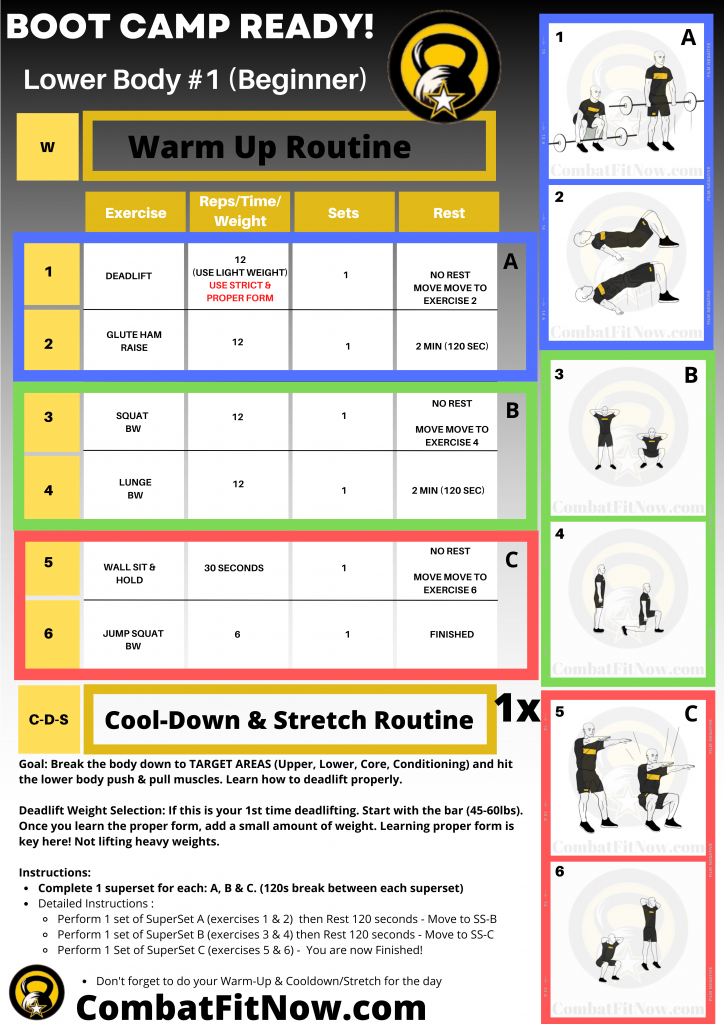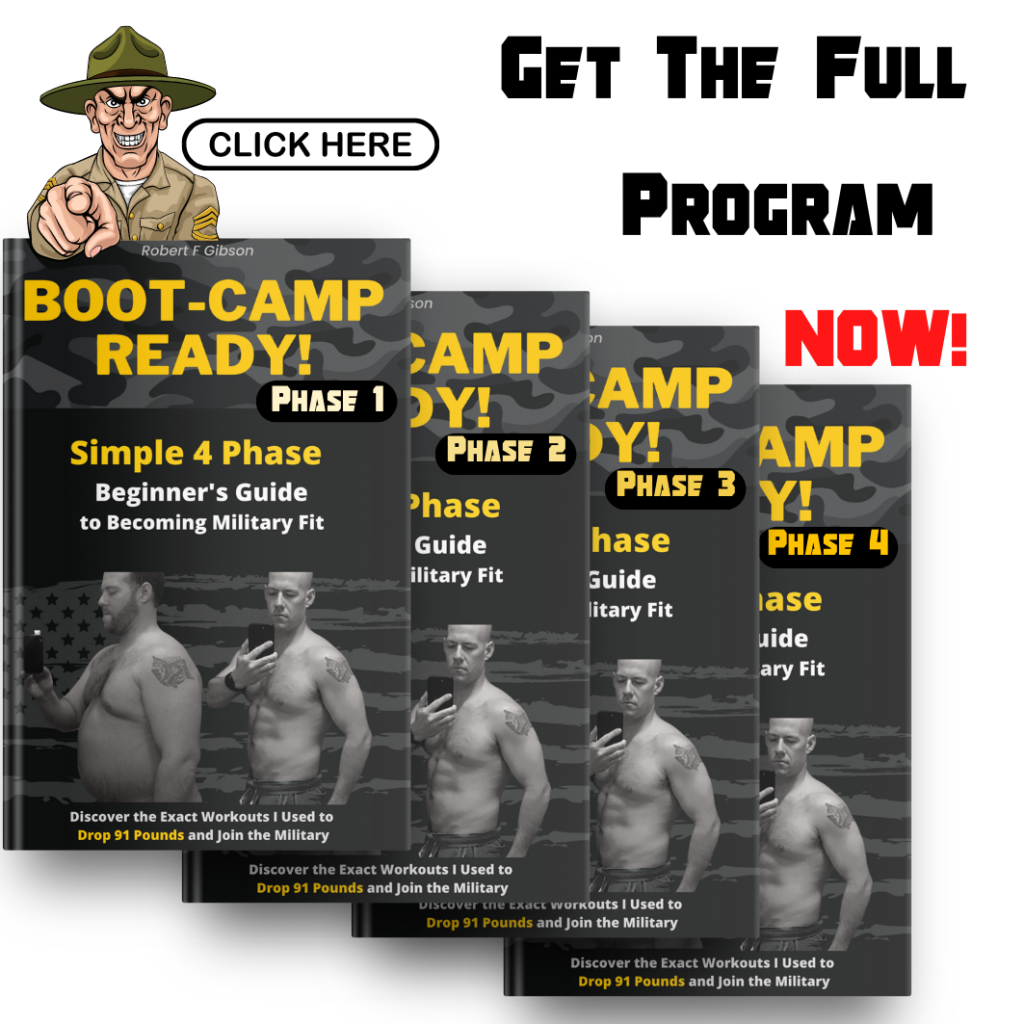Summary of Basic Training Workout #5 Lower Body
| Exercise | Reps | Sets | Rest | |
| 1 | Deadlift | 12 | 1 | 0 |
| 2 | Glute Ham Raise | 12 | 1 | 2 Min |
| 3 | Squat | 12 | 1 | 0 |
| 4 | Lunge | 12 | 1 | 2 Min |
| 5 | Wall Sit | 30 Sec | 1 | 0 |
| 6 | Jump Squat | 16 | 1 | – |
Description of Basic Training Workout #5 Lower Body
This leg/lower body workout is designed to target various muscle groups and build strength, endurance, and explosive power, essential for military fitness. Here’s a breakdown of each exercise and its benefits:
- Deadlift:
- Reps: 12
- Sets: 1
- Rest: 0 seconds
- The deadlift is a compound exercise that engages multiple muscle groups, including the hamstrings, glutes, lower back, and core. It helps improve overall strength and teaches proper lifting mechanics.
- Glute Ham Raise:
- Reps: 12
- Sets: 1
- Rest: 2 minutes
- The glute ham raise targets the hamstrings and glutes. It’s excellent for building strength in the posterior chain, which is crucial for running and jumping activities.
- Squat:
- Reps: 12
- Sets: 1
- Rest: 0 seconds
- Squats are fundamental for lower body development. They work the quadriceps, hamstrings, glutes, and lower back. Squats also help improve mobility and functional movement.
- Lunge:
- Reps: 12
- Sets: 1
- Lunges target the quadriceps, hamstrings, and glutes. They also engage the stabilizing muscles and promote balance and coordination, which are essential for military training.
- Wall Sit:
- Duration: 30 seconds
- Sets: 1
- Wall sits are an isometric exercise that primarily targets the quadriceps. This exercise helps build endurance and mental toughness, which is important for prolonged physical activities.
- Jump Squat:
- Reps: 16
- Sets: 1
- Jump squats are a plyometric exercise that combines the benefits of squats with explosive power. This helps improve agility and the ability to generate force quickly, which can be crucial in military scenarios.
Overall Benefits:
- Full Body Engagement: This workout engages multiple muscle groups in the lower body, promoting balanced development.
- Strength Building: The inclusion of compound movements like deadlifts and squats helps build overall strength.
- Endurance Training: Exercises like lunges and wall sits contribute to improved muscular endurance.
- Explosive Power: Jump squats focus on explosive power, which is beneficial for activities that require quick and forceful movements.
- Rest Intervals: Adequate rest intervals are provided to allow for recovery and maintain workout intensity.
For beginners preparing for military fitness, it’s crucial to start with proper form, gradually increase intensity, and listen to your body. This workout can be a solid foundation, but it’s essential to complement it with a well-rounded fitness routine that includes cardiovascular exercise, flexibility training, and upper body workouts. Additionally, ensure that your overall fitness plan aligns with the specific requirements of the military branch you’re preparing for.
Benefits of Basic Training Workout #5 Lower Body
Lower body muscular strength and muscular endurance are crucial for individuals looking to get into military shape for several reasons:
- Functional Movement Requirement:
- Military training often involves various physically demanding activities, including marching, running, hiking, and carrying heavy loads. Lower body strength and endurance are essential for these functional movements.
- Load-bearing Activities:
- Military personnel may be required to carry heavy equipment, backpacks, or gear for extended periods. Strong and enduring lower body muscles help individuals cope with the added load and reduce the risk of fatigue-related injuries.
- Endurance for Long Marches and Runs:
- Military training frequently involves long-distance marches and runs. Developing muscular endurance in the lower body is crucial for maintaining performance over extended periods, ensuring that individuals can cover the required distances efficiently.
- Terrain Challenges:
- Military operations can take place in diverse terrains, including rough and uneven surfaces. Strong lower body muscles provide stability and agility, helping individuals navigate challenging landscapes with ease.
- Power Generation:
- Explosive lower body strength is valuable for activities such as jumping, climbing, and navigating obstacles. This power generation is vital for overcoming physical challenges quickly and efficiently.
- Injury Prevention:
- Strengthening the muscles around the joints in the lower body can contribute to injury prevention. This is particularly important as military training often involves high-impact activities, and having a solid muscular foundation helps protect against strains and injuries.
- Overall Physical Preparedness:
- Lower body strength and endurance contribute significantly to overall physical preparedness. Military training is demanding and requires individuals to be well-rounded in their fitness levels. A strong lower body enhances overall physical performance and resilience.
- Body Armor and Load Carriage:
- Military personnel often wear body armor and carry additional equipment, increasing the load on their bodies. Lower body strength is crucial for supporting this added weight and maintaining mobility during missions.
- Core Stability:
- The lower body is closely connected to the core muscles. A strong and stable core is essential for maintaining good posture, balance, and overall physical control, which is vital in military training and operations.
For beginners aspiring to join the military, a well-rounded fitness program that prioritizes lower body strength and endurance, alongside cardiovascular fitness and overall muscular strength, is essential. Combining resistance training, cardiovascular exercise, and functional movements will help prepare individuals for the physical challenges they may face in military training and service.


